October 21st 2003
The main purpose of this diary entry is to talk about my trip to Nara on Sunday, but before I get onto that I suppose I should cover the events of the last couple of days. Lessons continue to be difficult -- the main problem is that we cover lots of new (to me, but not to everyone in the class) grammar every day, and as the explanations are in Japanese I don't always understand them very well. Thus, I feel like I'm constantly struggling to keep up. My kanji option class feels different. There, I feel comfortable with the material, and on top of things. The kanji class is fairly low for members of my general class, which probably explains the discrepancy.
The first issue of my Guardian Weekly subscription arrived yesterday, so thank you Mum. Now I can keep up with world news again. In addition, the parcel of books from England is nearly here -- it was held up in customs, but apparently that was sorted out while I was in class by the people in the gakuseika (the student affairs office). The explanations of both the problem and the solution were in Japanese, so while I know it was to do with concerns over what, exactly, books were, I'm not sure what the precise issue was. At any rate, it is apparently now solved.
OK, Nara...
Sunday October 19th
Nara was a day trip. Nara is about three hours' drive from Okazaki, so it was quite a long day trip. In fact, the posted leaving time was seven am. This was less difficult for me now that I have to be up, dressed, and fifteen minutes' walk away in school by nine am every day, but it still wasn't fun. Declan Murphy, the international director at Yamasa, drives the minibus for the trips, and he picked everyone up from their accommodation. I was the penultimate pickee, so it was about twenty past seven before I actually left my flat. Fortunately, it was a beautiful morning, so waiting outside was no problem.
There were seven students in total on the trip. In addition to me, there was an American guy, three Italian women, an American woman, and a Korean woman. Most of them are doing the SILAC courses, which come in units of two weeks, but one of the Italian women is also doing the AIJP.
The journey to Nara was uneventful, which is good, but the scenery was spectacular. We drove across the bay at Nagoya, where most of the land you can see is artificial or reclaimed, and through the mountains to Nara. The views from the road were periodically spectacular, and periodically restricted to the side of a mountain right next to us.
We got to Nara shortly after ten am, which meant that it was easy to find a parking space. By the time we got back to the minibus at about half past two, the car parks were absolutely full. Because it was a nice day, we (the group) opted for the version of the trip that involved more outdoor stuff instead of a ceramics museum, and I think it was the right choice.
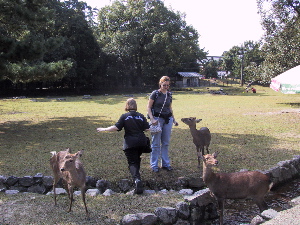 The deer in Nara Koen, being unafraid of Yamasa students.
The deer in Nara Koen, being unafraid of Yamasa students.
Nara was the capital of Japan for much of the eighth century, before the capital moved to Kyoto, originally called Heian, where it stayed for over a thousand years, until the mid-nineteenth century, when it moved to Tokyo. When the government left, the city fell into decay, so there is little left of the ancient monuments. The remains are temples, shrines, and some earthwork burial mounds that were just too big to disappear. We didn't see all of Nara, just the area in Nara Koen (Nara park). Nara park has lots of deer. It is traditional for tourists to feed the deer, buying deer food from vendors all over the park. As a result, the deer are not very frightened of people, and come and pester you to see if you have food. If you bow before giving them food, they will also bow back, as Declan demonstrated, which looks rather comical.
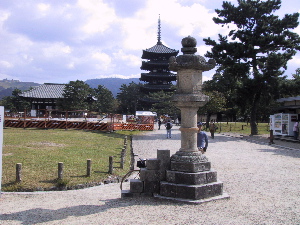 Kofukuji, with the pagoda.
Kofukuji, with the pagoda.
Our first stop of the day was Kofukuji. (Remember 'ji' means 'temple'.) This temple was founded by the Fujiwara clan, the second most powerful clan in ancient Japan, after the Imperial family. Actually, it could be argued that from the tenth century to the mid eleventh, at least, the Fujiwaras were actually more powerful than the Imperial clan. The temple, like just about everything else in Japan, has burned down repeatedly, so nothing remains that is older than the thirteenth century. The five-storey pagoda, the second tallest in Japan, was rebuilt for the fifth time in 1426, and it is an exact replica of the original, which was built in 730. There were preparations for some sort of exhibition in progress, so you can see the temporary fences in the picture. There is a treasure house, which serves as a museum, here, but we didn't have time to go there.
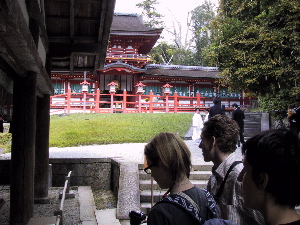 Kasuga Grand Shrine. You can see the bride from the wedding, in white, in the middle distance.
Kasuga Grand Shrine. You can see the bride from the wedding, in white, in the middle distance.
Instead, we set off walking to visit Kasuga Grand Shrine. This was the tutelary shrine of the Fujiwaras, and so also extremely important. As luck would have it, a wedding was in progress while we were there. This was not allowed to stop the influx of tourists bearing money, so we were able to see the priests and miko (shrine maidens) conducting a ceremony. It was quite simple and rather beautiful, if more than a little mystifying to those of us with minimal knowledge of Shinto. The approaches to the shrine, and the area around it, are lined with stone lanterns, on which prayers can be posted in return for a donation. One of them is made of petrified wood, and apparently it is slightly more expensive to have your prayer posted here. Presumably the kami look here first.
After that, more walking, to visit a very big bell housed in an independent building, and Nigatsudou, which I think is a Buddhist temple, although it could conceivably also be a Shinto shrine. I took lots of pictures (about sixty in total during the day), but the pictures here are restricted to the most important sites. And these weren't them.
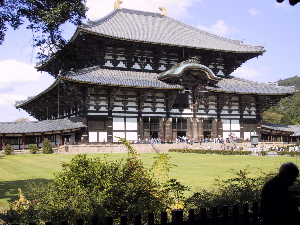 The Daibutsuden at Todaiji.
The Daibutsuden at Todaiji.
After lunch, we went to Toudaiji (East Big Temple), which houses a large bronze Buddha. The temple is, indeed, big. The Daibutsuden (big Buddha hall), which houses the Daibutsu (big Buddha), is the largest wooden structure in the world. It's also only two thirds of its original size, as it burned down a few times and by the seventeenth century the third Tokugawa shogun, Iemitsu, didn't feel like shelling out to rebuild it full scale.
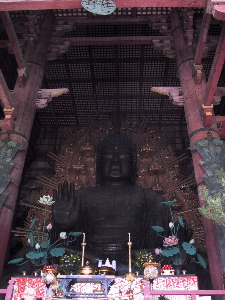 The Daibutsu, an enormous bronze Buddha statue.
The Daibutsu, an enormous bronze Buddha statue.
Inside the Daibutsuden is the main attraction of Nara, the Daibutsu. This is the second-largest bronze Buddha statue in Japan, and possibly the world. It was originally constructed in the eighth century, but it has been repaired a number of times since then, having been damaged in earthquakes and when the temple burned down around it. The current head, for example, is late seventeenth century. The statue is just under fifteen metres tall, and really very impressive. The photograph doesn't convey its scale in the slightest. It completely dominates the hall, and it is possible to walk all the way around it. If you do so, you can also see a number of other statues, and a reconstructed model of the original condition of the temple -- bigger, and with two seven-storey pagodas, one to either side. The roof is held up by enormous wooden pillars, one of which has a hole through the base. Apparently, if you can get through the hole, you are guaranteed enlightenment. While we were there, there was a queue of small children being sent through by their parents -- it's quite easy if you're, say, four.
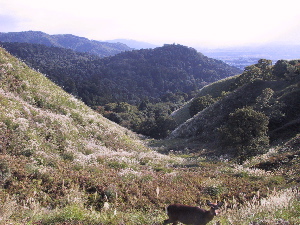 The view down a valley from a path on Wakasayama. With another not-frightened-of-people deer.
The view down a valley from a path on Wakasayama. With another not-frightened-of-people deer.
After Toudaiji, we went back to the minibus for the drive up Wakasayama, which isn't really a mountain but does have a superb view. The drive was quite exciting as well, as the road is very winding, very steep, and very narrow. And two-way. Mind you, Japanese roads in general make British roads look wide. From the top of the hill it is possible to see both Nara and Kyoto, and the almost continuous building between them. There was still quite a bit of green on the plains, but Declan said it would all be concrete within fifteen years, so I took photographs. The mountains are probably safe for a while longer, as the slopes are too steep for easy construction.
Wakasayama was the last stop of the day, so we went back to the minibus to drive home. Declan dropped people at various points, depending on where they wanted to eat and so on, and I got to bed a little before nine, so that I could get up for lessons on Monday. It was a good trip, but I definitely can't manage to do them every week, quite apart from not being able to afford that many. I need the weekend to do things like my laundry, and clean the flat.